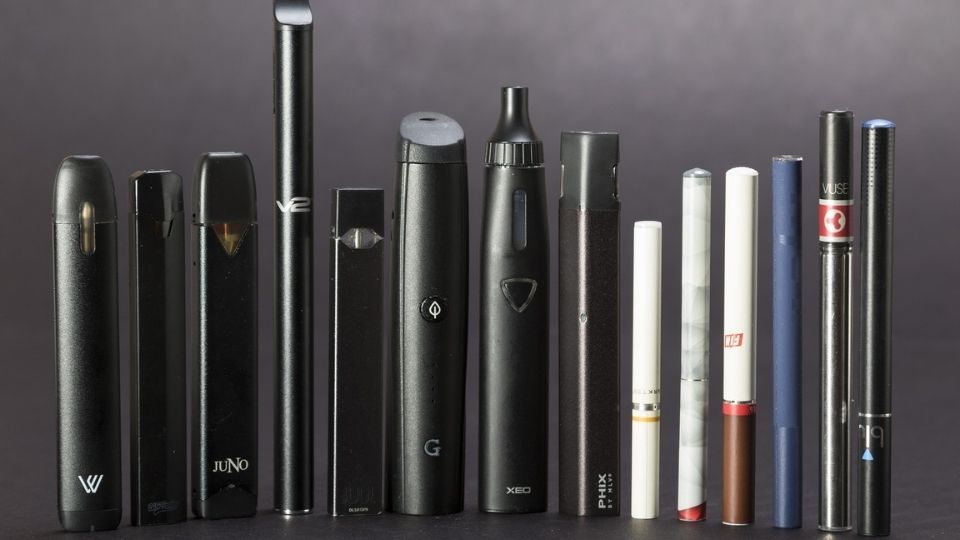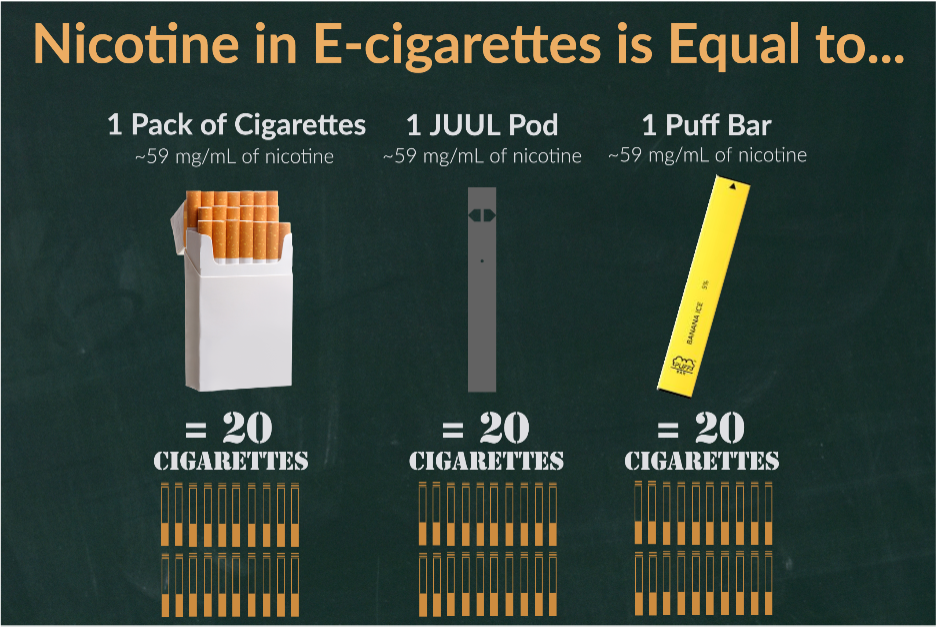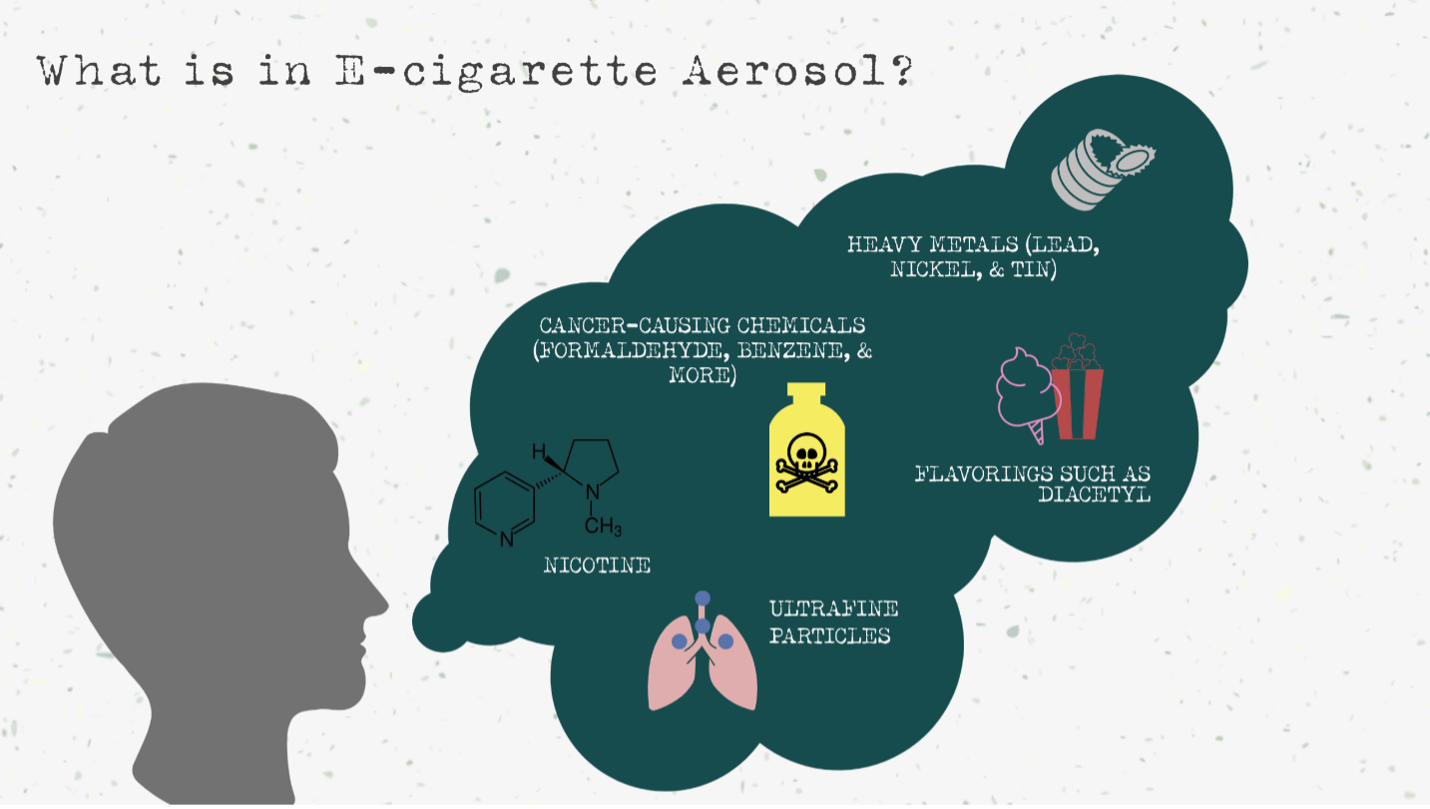The Truths Behind Vaping: Information for Youth and Teens

What are E-cigarettes?
E-cigarettes, including vape pens, mods, pods, and cig-a-like, have been available in the U.S. since 2006 (Chun et al., 2017). These battery-operated devices contain an e-liquid inside of a tank. When the e-liquid inside is heated by an atomizer it vaporizes into an aerosol (CATCH, 2020). An aerosol is a thick mist or spray, containing substances with many harmful chemicals and is often referred to as a “vapor” (CATCH, 2020). Aerosol from e-cigarettes is similar to canned hairspray; it sprays out at a high-pressure and leaves a sticky layer behind. Using the term "vapor" rather than "aerosol" makes e-cigarettes seem not as harmful as they actually are – but they are very harmfu. Keep reading to see why!
vaporizes into an aerosol (CATCH, 2020). An aerosol is a thick mist or spray, containing substances with many harmful chemicals and is often referred to as a “vapor” (CATCH, 2020). Aerosol from e-cigarettes is similar to canned hairspray; it sprays out at a high-pressure and leaves a sticky layer behind. Using the term "vapor" rather than "aerosol" makes e-cigarettes seem not as harmful as they actually are – but they are very harmfu. Keep reading to see why!
What are the E-cigarette Harms and Risks?
The e-liquid or e-juice placed inside an e-cigarette is not just flavoring. There are several harmful ingredients including the following ingredients and impacts:
E-Cigarettes Contain Nicotine with Harmful Impacts
While many people believe that there is no nicotine in their e-liquid, 99% of e-cigarette product sales have nicotine (Marynak et al., 2017). Labels can be misleading, as some e-cigarettes labeled as having ‘zero nicotine’ actually do have nicotine in them (CATCH, 2020). Because there are few rules about labeling, consumers are often unaware of the actual ingredients included in e-cigarettes when buying them (CATCH, 2020; Cobb et al., 2020).
Using products with nicotine can have serious impacts on your health, such as:
- Disrupting the connections built between your brain cells, called synapse formation. This can lead to increased daily use of other drugs;
- Changes in the development of memories;
- Difficulty focusing and concentrating on tasks;
- Extreme mood swings; and
- Making you unexplainably angry or impatient (CATCH, 2020; Dwyer et al., 2009; Stalgaitis et al., 2020).
Nicotine is a habitual product - once a person starts using it, it can become very difficult to quit using. Did you know that JUUL has so much nicotine that when the aerosol enters your body it increases the chances of daily e-cigarette use (Hajek et al., 2020). In fact, JUUL has the same amount of nicotine as an entire pack of cigarettes (Singh et al., 2020). That's a lot!

(Adapted from Stanford Medicine, n.d.)
E-liquid Ingredients are Harmful
E-liquid contains propylene glycol and vegetable glycerin that once heated changes to form aldehyde. Aldehyde is toxic to the human body (Fadus et al., 2019). Other toxic ingredients are found in this harmful mixture including dangerous substances like:
- Formaldehyde: A group one cancer-causing agent, also used in the preservation of dead specimens, like frogs (Jensen et al., 2015; Rubinstein et al., 2018). Biology classes use formaldehyde but side effects of inhaling and touching can include irritation of the eyes, nose, skin, throat, dizziness and fatigue (Bhat et al., 2019). Meanwhile, vaping formaldehyde may deposit cancerous agents into the lungs of e-cigarette users (Jensen et al., 2012).
- Benzene: Used in rubbers, dyes, and detergents and can lead to leukemia (i.e., an uncurable blood cancer; Rubinstein et al., 2018; Zhou et al., 2020).
- Heavy metals: Such as lead, nickel, and tin are also in e-cigarette products. These are all cancer-causing agents as well (CATCH, 2020).
If you vape, you are at risk for lung issues such as asthma and bronchitis and can have severe cases of these infections (Cho & Paik, 2016; Stalgaitis et al., 2020). For example, most youth e-cigarette users at 13 different Utah hospitals had to be moved to the intensive care unit (ICU) or to a larger hospital to be treated due to difficulties related to vaping (Blagev et al., 2019). Chemicals that are dangerous to inhale and contribute to the development of lung injuries include:
- Vitamin E Acetate: Most often found in tetrahydrocannabinol (THC) vape products. Vitamin E acetate is strongly linked to the development of EVALI (E-cigarette or vaping product use-associated lung injury; CATCH, 2020). The CDC highly recommends that you never try THC-containing e-cigarettes due to these dangerous side-effects (CDC, n.d.).
- Diacetyl: A flavoring chemical in e-liquid. Diacetyl adds to the development of asthma, chronic obstructive pulmonary disease (COPD; a life-long disease that blocks the flow of air), and popcorn lung (another life-long disease that makes it very hard to breath; Rose, 2017; Vape Danger, n.d). Diacetyl helps mask the taste of the dangerous chemicals and nicotine so that users will want to keep using e-cigarettes (Leventhal et al., 2020). Four out of five (81%) of the young individuals who have used tobacco products started with a flavored product like e-cigarettes in 2013 & 2014 (CATCH, 2020).
Additionally, the lungs of people who vape are at risk of inhaling glass pieces from aerosol chemical elements (Cho & Paik, 2016). Nausea, vomiting, mouth sores, general chest pain, and increased heart rate have also been reported after vaping (Alzahrani et al., 2018; Blagev et al., 2019; CATCH, 2020). All that extra harm doesn't seem worth it.

(Adapted from CDC, n.d.)
E-cigarette use Harms Other People, too
If you vape you could also be hurting the people closest to you. E-cigarette use has secondhand dangers just like traditional cigarettes. Children such as younger siblings are at risk of experiencing nicotine effects from e-liquids and toxic aerosols through direct contact or through secondhand inhalation (Callahan-Lyon, 2014). Younger siblings also are at risk of swallowing e-liquids, many cases of e-liquid consumption have been reported since 2013 (CATCH Curriculum, 2020). E-liquid or e-juice that is swallowed can kill someone. Find an adult immediately if you see someone drinking e-cigarette products.
Cigarettes & E-cigarettes:
Currently, there is not enough information available to know if e-cigarettes help people quit smoking or not, however; we do know that the majority of youth who vape are actually starting tobacco use with vape products. Yikes! Utah’s SHARP Survey for the Four Corners area (including 6th, 8th, 10th, & 12th grade students in Grand, Carbon, and Emery counties) shows that 62.8% of the students’ first use of tobacco was with e-cigarettes (Bach-Harrison, 2020).
Not only this, but it has been found that youth who vape are 6.8 times more likely to start smoking cigarettes within 18 months compared to youth who do not use e-cigarettes (CATCH, 2020). It has also been shown that e-cigarette users smoke more traditional cigarettes in a month compared to non-e-cigarette users (Soneji et al., 2017; Stalgaitis et al., 2020; Pierce et al., 2021). Utah’s 2019 SHARP Survey showed that 90% of Four Corner’s students who said they had vaped within the past 30 days had also used cigarettes within the last month (Bach-Harrison, 2020).
Additionally, the use of both e-cigarettes and traditional cigarettes at the same time, or dual use, is strongly associated with other unhealthy substance use, binge drinking, poor academics, and marijuana use (Evans-Polce et al., 2020).
Youth Pressures:
E-cigarette exposure and pressures can occur from many different places. Recognizing and knowing what pressure looks like and where it comes from can help you avoid and refuse e-cigarettes. Help keep others informed as well on the following sources of pressure:
- Peer Pressure: Vaping is viewed as a social activity and is often driven by peers who are already using e-cigarettes (Wyman et al., 2020). However, in the Four Corners District, 84.9% of students who had positive peers, or friends who were involved in positive and meaningful activities, also chose not to use vape products in 2019 (Bach-Harrison, 2020). You can also choose not to use e-cigarettes by surrounding yourself with friends who won’t pressure you and participate in fun positive clubs.
- Advertising Pressure: Marketers are getting creative with the ways they advertise, often using retail stores, the internet, TV, streaming services, movies, magazines, social media outlets, and influencers to get youth to use their tobacco products (CATCH, 2020). In fact, 70% of young individuals are regularly shown e-cigarette advertisements and sometimes are unable to recognize them as ads (CATCH, 2020). Make sure to think critically about the pictures and media you see daily and try to recognize hidden advertisements.
- Self-Pressure: Sometimes individuals place pressure on themselves by thinking that everyone else is vaping and that they must also use e-cigarettes to be included. In reality, the majority of youth in Southeast Utah chose not to vape; over 83% of the students did not use e-cigarettes in the past 30 days in 2019 (Bach-Harrison, 2020). That’s right, most of your peers don’t vape!
How Do I Resist Pressure to Vape?
How to Refuse |
Say “no” assertively and with confidence. Back up your refusal with a reason for not trying e-cigarettes (use one of the reasons in this fact sheet). Don’t be afraid to add a little humor and make it something that you are comfortable saying. The more confidence and ease an individual has with refusing, the less likely others will try to keep pressuring. Example: “No. I’m good, I don’t want to inhale any extra chemicals.” |
How to Get Out of the Situation |
Suggest a different activity and distract others with something else to do. Making up an excuse to leave is also a great exit strategy, so be prepared with a reason why you can’t ahead of time. If you can, avoid being around smokers/vapers who pressure you before it happens. Again, be confident and deliberate with the delivery of your exit strategy. Example: “Let’s grab something to eat instead, before lunch is over.” |
(CATCH Curriculum, 2020). For more examples visit: https://www.kidpower.org/library/article/tobacco-refusal/
There are many reasons not to use e-cigarettes, and lots of positive alternatives you can do instead!
Focus your energy on getting out and taking a walk, learning an instrument, reading a book, or trying a new food you’ve never had. It’s important to be aware of the habits that we are forming every day. Make sure that your healthy daily actions outweigh any unhealthy ones. For more ideas see the Healthy Choices Calendar and other resources for youth below.
Resources*:
-
Healthy Choices Calendar:
Challenge yourself by picking a month and writing down a healthy choice to do every day. Click here for an example and a calendar to print.
-
Myths Exposed: https://www.bevapefree.org/virtual-field-trip/
-
E-cigarette videos, activities, and articles: http://www.scholastic.com/vapingrisks/index.html
-
How to Quit: https://teen.smokefree.gov/quit-vaping/how-to-quit-vaping
-
Quit Plan: https://teen.smokefree.gov/vaping-quit-plan
-
Download tobacco free apps:
Escape the Vape https://apps.apple.com/us/app/escape-the-vape/id1482436533
Quuit-Quit Vaping Now: https://apps.apple.com/us/app/quuit-quit-vaping-now/id1493133459
-
Get Support from doctors, teachers, and other leaders/adults in your community.
-
Text DITCHVAPE to 88709
*Please note that all of the resources provided are for educational purposes and Utah State University (USU) does not specifically endorse their services. Resources are intended to provide information, not to treat substance use/vape use or other mental health concerns. USU does not control the websites or books referenced above.
References:
-
Alzahrani, T., Pena, I., Temesgen, N., & Glantz, S. A. (2018). Association Between Electronic Cigarette
Use and Myocardial Infarction. American Journal Preventive Medicine. 55(4): 455-461.
-
Bach-Harrison (2020). Utah Department of Human Services: Substance Abuse and Mental Health: Utah
SHARP Web Tool. Retrieved November 25, 2020 from http://www.bach-harrison.com/utahsharpwebtool/Crosstabs.aspx
-
Bhat, D., Chittoor, H., Murugesh, P., Basavanna, P. N., Doddaiah, S. (2019). Estimation of Occupational
Formaldehyde Exposure in Cadaver Dissection Laboratory and its Implications. Anatomy & Cell Biology 2019;52: 419-425. https://doi.org/10.5115/abc.19.105
-
Blagev, D. P., Harris, D., Dunn, A. C., Guidry, D. W., Grisson, C. K., & Lanspa, M. J. (2019). Clinical
Presentation, Treatment, and Short-term Outcomes of Lung Injury Associated with E-cigarettes or Vaping: A Prospective Observational Cohort Study. Lancet, 394(10214), P2073-P2083. https://doi.org/10.1016/S0140-6736(19)32679-0
-
Callahan-Lyon, P. (2014). Electronic Cigarettes: Human Health Effects. Tobacco Control, 23: ii36-ii40.
-
CATCH-My-Breath., Curriculum. (2020). CATCH My Breath Vaping Prevention Program: Curriculum.
Accessed on November 27, 2020 from https://letsgo.catch.org/courses/take/catch-my-breath-e-cigarette-juul-prevention
-
CATCH-My-Breath. (2020). CATCH My Breath Vaping Prevention Program: State of the Union of the
Youth vaping Epidemic and Introduction to an Evidence-based prevention program. Accessed on November 27, 2020 from https://letsgo.catch.org/
-
Centers for Disease Control and Prevention [CDC]. (n.d.). Quick facts on the Risks of E-cigarettes for Kids, Teens, and Young Adults [graphic adapted from]. Retrieved from https://www.cdc.gov/tobacco/basic_information/e-cigarettes/Quick-Facts-on-the-Risks-of-E-cigarettes-for-Kids-Teens-and-Young-Adults.html
-
Centers for Disease Control and Prevention [CDC]. (n.d.). Smoking & Tobacco Use: Outbreak of Lung Injury Associated with E-cigarette Use, or Vaping. Retrieved January 8, 2021 from https://www.cdc.gov/tobacco/basic_information/e-cigarettes/severe-lung-disease.html#key-facts-vit-e
-
Cho, J. H. & Paik, S. Y. (2016). Association between electronic cigarette use and asthma among high school students in South Korea. PLoS One, 11(3), e0151022. https://doi.org/10/1371/journal.pone.0151022
-
Chun, L., Moazed, F., Calfee, C., Matthay, M., & Gotts, J. (2017). Pulmonary Toxicity of E-cigarettes.
American Journal of Physiology, 313(2), L193-L206. https://doi.org/10.1152/ajplung.00071.2017
-
Cobb, N. K., & Solanki, J. N. (2020). E-cigarettes, Vaping Devices, and Acute Lung Injury. Respiratory
Care,66(5), 713-718. https://doi.org/10.4187/respcare.07733
-
Dwyer, J. B., McQuown, S. C., & Leslie, F. M. (2009). The dynamic effects of nicotine on the developing brain. Pharmacology & Therapeutics, 122(2), 125-139. https://doi.org/10.1016/j.pharmthera.2009.02.003
-
Evans-Polce, R. J., Veliz, P., Boyd, C. J., & McCabe, S. E. (2020). Initiation Patterns and Trends of E-cigarettes and Cigarette Use Among U.S. Adolescents. Journal of Adolescent Health, 66(1), 27-33. https://doi.org/10.1016/j.jadohealth.2019.07.002
-
Fadus, M. C., Smith, T. T., & Squeglia, L. M. (2019). The Rise of E-cigarettes, Pod Mod Devices, and JUUL Among Youth: Factors Influencing Use, Health Implications, and Downstream Effects. Drug and Alcohol Dependence, 201, 85-93. https://doi.org/10.1016/j.drugalcdep.2019.04.011
-
Hajek, P., Pittaccio, K., Pesola, F., Smith, K. M., Phillips-Waller, A., & Przulj, D. (2020). Nicotine Delivery and Users’ Reaction to JUUL Compared with Cigarettes and Other E-cigarettes Products. Addiction, 115(6), 1141-1148. https://doi.org/10.1111/add.14936
-
Jensen, R. P., Luo, W., Pankow, J. F., Strongin, R. M., Peyton, D. H. (2015). Hidden Formaldehyde in E-cigarette Aerosols. New England Journal of Medicine, 2015, 372:392-394. https://doi.org/10.1056/NEJMc1413069
-
Leventhal, A. M., Mason, T. B., Cwalina, S. N., Whitted, L., Anderson, M. K., & Callahan, C. E. (2020). Flavor and Nicotine Effects on E-cigarette Appeal in Young Adults: Moderation by Reason for Vaping. American Journal of Health Behavior, 44(5), 732-743. https://doi.org/10.5993/AJHB.44.5.15
-
Marynak, K. L., Gammon, D. G., Rogers, T., Coats, E. M., Singh, T., & King, B. A. (2017). Sales of Nicotine-Containing Electronic Cigarettes Products: United States, 2015. American Journal of Public Health, 107(5), 702-705. https://doi.org/10.2105/AJPH.2017.303660
-
Pierce, J. P., Chen, R., Leas, E. C., White, M. M., Kealey, S., Stone, M. D., Behmarhnia, T., Trinidad, D. R., Strong, D. R., & Messer, K. (2021). Use of E-cigarettes and Other Tobacco Products and Progression to Daily Cigarette Smoking. Pediatrics, 2021, e2020025122. https://doi.org/10.1542/peds.2020-025122
-
Rose, C. S. (2017). Early Detection, Clinical Diagnosis, and Management of Lung Disease from Exposure to Diacetyl. Toxicology 388 (2017) 9-14. https://doi.org/10.1016/j.tox.2017.03.019
-
Rubinstein, M. L., Delucchi, K., Benowitz, N. L., & Ramo, D. E. (2018). Adolescent Exposure to Toxic Volatile Organic Chemicals from E-cigarettes. Pediatrics, 141(4), e20173557. https://doi.org/10.1542/peds.2017-3557
-
Singh, S., Windle, S. B., Filion, K. B., Thombs, B. D., O’Loughlin, J. L., Grad, R., & Eisenberg, M. J. (2020). E-cigarettes and Youth: Patterns of Use, Potential Harms, and Recommendations. Preventive Medicine, 133, 106009. https://doi.org/10.1016/j.ypmed.2020.106009
-
Soneji, S., Barrington-Trimis, J. L., Wills, T. A., Leventhal, A. M., Unger, J. B., Gibson, L. A., Yang, J.,...Sargent, J. D. (2017). Association Between Initial Use of E-cigarettes and Subsequent Cigarette Smoking Among Adolescents and Young Adults: A systematic Review and Meta-analysis. JAMA Pediatr. 2017; 171(8): 788-797. https://doi.org/10.1001/jamapediatrics.2017.1488
-
Stalgaitis, C. A., Djakaria, M., & Jordan, J. W. (2020). The Vaping Teenager: Understanding the Psychographics and Interests of Adolescent Vape Users to Inform Health Communication Campaigns. Tobacco Use Insights, 13. https://doi.org/10.1177%2F1179173X20945695
-
Stanford Medicine (n.d.). Tobacco Prevention Toolkit: Cigs in a Pod [graphic adapted from]. Retrieved from https://med.stanford.edu/content/dam/sm/tobaccopreventiontoolkit/documents/ecigarettes/Cigs-in-a-Pod.pdf
-
Vape Danger. (n.d.) Vaping health risks. Vape Danger. Retrieved December 7, 2020 from https://www.vapedanger.com/health-risks/
-
Wyman, P.A., Rulison, K., Pisani, A. R., Alvaro, E. M., Schmeelk-Cone, K., … & Espelage, D. L. (2020). Above the Influence of Vaping: Peer Leader Influence and Diffusion of a Network-Informed Preventive Intervention. Addictive Behaviors, 113. https://doi.org/10.1016/j.addbeh.2020.106693
-
Zhou, Y., Wang, K., Wang, B., Pu, Y., & Zhang, J. (2020). Occupational Benzene Exposure and the Risk of Genetic Damage: A Systematic Review and Meta-analysis. BioMed Central Public Health 2020; 20:1113. https://doi.org/10.1186/s12889-020-09215-1
Authors
Jenna Hawks, Health and Wellness Prevention Coordinator; Jordyn Oman, Health and Wellness Prevention Coordinator; Hailey Judd, Health and Wellness Coordinator; Ashley Yaugher, Professional Practice Extension Assistant Professor; Cris Meier, Community Resource and Economic Development Specialist; Christina Pay, Extension Assistant Professor
Related Research












